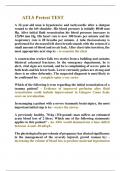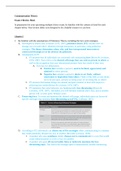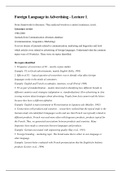Week 3:
Preparation: Chap 7: Investment
Decision Rules
The NPV investment rule is the decision rule managers should use to maximize
firm value. But some other techniques can be used by the firms like the payback
rule or internal rate of return rule.
Considering a take-it-or-leave-it decision involving a single, stand alone project.
But undertaking it, the firm doesn’t constrain its ability to take others.
NPV investment rule: when making an investment decision, take the alternative
with the highest NPV. Choosing this alternative is equivalent to receiving its NPV
in cash today. When comparing to nothing, NPV should be compared to 0 and be
accepted if > 0.
Its case of uncertainty regarding the project’s cost of capital: compute the NPV
profile – a graph of the project’s NPV over a range of discount rates.
NPV > 0 only for a discount rate < 14%
The difference between the cost of capital and the IRR is the maximum
estimation error in the cost of capital that can exist without altering the original
decision.
Alternative rules do not always give the same answer, so might not be the most
reliable.
The IRR Investment Rule: take any investment opportunity where the IRR
exceeds the opportunity cost of capital. Turn down any opportunity whose IRR is
less than the opportunity cost of capital.
The IRR rule is only guaranteed to work for a stand-alone project if all of the
project’s negative cash flows precede its positive cash flows.
In case of multiple IRRs, the only choice is the NPV rule. When no IRR, NPV ≠ 0.
Sign has still to be studied.
The payback investment rule: states that you should only accept a project if its
cash flows pay back its initial investment within a prespecified period.
Payback period: the amount of time it takes to pay back the initial investment. If
< prespecified length of time: should accept.
Not as reliable as NPV because: ignores the project’s cost of capital and the time
value of money; ignore cash flows after the payback period; relies on an ad hoc
decision criterion (what is the right number of years to require as payback
period?).
Firms might just save time by applying this rule, and only if it fails then apply the
NPV one.
When many projects mutually exclusive, NPV give a straightforward answer: pick
the project with the highest NPV.
Because the IRR is a measure of expected return of investing in the project, we
might be tempted to extend the IRR investment rule to the case of mutually
exclusive projects by picking the one with the highest IRR.
When projects differ in their scale of investment, the timing of their cash flows,
or their riskiness, then their IRRs cannot be meaningfully compared.
NPV doubling double the cash flows, but the IRR doesn’t follow this rule.
, We can compare IRRs by calculating incremental IRR: the IRR of the incremental
cash flows that would result from replacing one project with another but has the
same problem as the IRR rule.
NPV rule limit: in practice, there are often limitations on the number of projects
the firm can undertake, often due to resources constraints.
Profitability Index = Value Created / Resource Consumed = NPV / Resource
Consumed
Measures the ‘bang for your buck’ – the value created in terms of NPV/ unit of
resources consumed.
To be completely reliable:
- The set of projects taken following the index ranking completely exhausts
the available resource.
- There is only a single resource constraint.
Chap 8: Fundamentals of Capital Budgeting
Capital budgeting: the process of analyzing investment opportunities and
deciding which ones to accept.
A capital budget lists the projects and investments a company plans to
undertake during the coming year.
Earnings are not actual cash flows.
However, first step is to forecast earnings: determine the incremental earnings of
a project – the amount by which the firm’s earnings are expected to change as a
result of the investment decision.
Simplest method to calculate depreciation: straight line depreciation.
When evaluating a capital budgeting decision, interest expenses are excluded.
So the NI is referred as unlevered NI of the project.
The correct tax rate to use is the firm’s marginal corporate tax rate, the one it
will pay on an incremental dollar of pre-tax income. Income Tax = EBIT x
TC (firm’s M corporate tax rate)
Unlevered Net Income = EBIT(revenue – costs – depreciation) x (1 – Tc)
When computing incremental earnings, all changes between the firm’s earnings
with the project VS without should be included.
Should include opportunity cost (of a resource etc); project externalities
(external effect that could incr. or decr. Profits of other business activities of the
firm – cannibalization can occur when sale of a product displaces another
product’s).
Sunk cost: unrecoverable cost for which the firm is already liable. They have
been or will be paid regardless of the decision about whether or not to proceed
with the project. Do not forget that if our decision does not affect the cash flow,
then the cash flow should not affect our decision.
Incremental expenses include additional overhead expenses arising because of
the decision to take on the project.
Past research and Development expenditures can be considered as “waste” if
project abandoned du to market changement, but in fact should be considered
as irrelevant sunk cost.
Unavoidable Competitive effects (cuz from competitors) Sunk Costs.
For most industries, competition tend s to reduce profit margins over time.
Preparation: Chap 7: Investment
Decision Rules
The NPV investment rule is the decision rule managers should use to maximize
firm value. But some other techniques can be used by the firms like the payback
rule or internal rate of return rule.
Considering a take-it-or-leave-it decision involving a single, stand alone project.
But undertaking it, the firm doesn’t constrain its ability to take others.
NPV investment rule: when making an investment decision, take the alternative
with the highest NPV. Choosing this alternative is equivalent to receiving its NPV
in cash today. When comparing to nothing, NPV should be compared to 0 and be
accepted if > 0.
Its case of uncertainty regarding the project’s cost of capital: compute the NPV
profile – a graph of the project’s NPV over a range of discount rates.
NPV > 0 only for a discount rate < 14%
The difference between the cost of capital and the IRR is the maximum
estimation error in the cost of capital that can exist without altering the original
decision.
Alternative rules do not always give the same answer, so might not be the most
reliable.
The IRR Investment Rule: take any investment opportunity where the IRR
exceeds the opportunity cost of capital. Turn down any opportunity whose IRR is
less than the opportunity cost of capital.
The IRR rule is only guaranteed to work for a stand-alone project if all of the
project’s negative cash flows precede its positive cash flows.
In case of multiple IRRs, the only choice is the NPV rule. When no IRR, NPV ≠ 0.
Sign has still to be studied.
The payback investment rule: states that you should only accept a project if its
cash flows pay back its initial investment within a prespecified period.
Payback period: the amount of time it takes to pay back the initial investment. If
< prespecified length of time: should accept.
Not as reliable as NPV because: ignores the project’s cost of capital and the time
value of money; ignore cash flows after the payback period; relies on an ad hoc
decision criterion (what is the right number of years to require as payback
period?).
Firms might just save time by applying this rule, and only if it fails then apply the
NPV one.
When many projects mutually exclusive, NPV give a straightforward answer: pick
the project with the highest NPV.
Because the IRR is a measure of expected return of investing in the project, we
might be tempted to extend the IRR investment rule to the case of mutually
exclusive projects by picking the one with the highest IRR.
When projects differ in their scale of investment, the timing of their cash flows,
or their riskiness, then their IRRs cannot be meaningfully compared.
NPV doubling double the cash flows, but the IRR doesn’t follow this rule.
, We can compare IRRs by calculating incremental IRR: the IRR of the incremental
cash flows that would result from replacing one project with another but has the
same problem as the IRR rule.
NPV rule limit: in practice, there are often limitations on the number of projects
the firm can undertake, often due to resources constraints.
Profitability Index = Value Created / Resource Consumed = NPV / Resource
Consumed
Measures the ‘bang for your buck’ – the value created in terms of NPV/ unit of
resources consumed.
To be completely reliable:
- The set of projects taken following the index ranking completely exhausts
the available resource.
- There is only a single resource constraint.
Chap 8: Fundamentals of Capital Budgeting
Capital budgeting: the process of analyzing investment opportunities and
deciding which ones to accept.
A capital budget lists the projects and investments a company plans to
undertake during the coming year.
Earnings are not actual cash flows.
However, first step is to forecast earnings: determine the incremental earnings of
a project – the amount by which the firm’s earnings are expected to change as a
result of the investment decision.
Simplest method to calculate depreciation: straight line depreciation.
When evaluating a capital budgeting decision, interest expenses are excluded.
So the NI is referred as unlevered NI of the project.
The correct tax rate to use is the firm’s marginal corporate tax rate, the one it
will pay on an incremental dollar of pre-tax income. Income Tax = EBIT x
TC (firm’s M corporate tax rate)
Unlevered Net Income = EBIT(revenue – costs – depreciation) x (1 – Tc)
When computing incremental earnings, all changes between the firm’s earnings
with the project VS without should be included.
Should include opportunity cost (of a resource etc); project externalities
(external effect that could incr. or decr. Profits of other business activities of the
firm – cannibalization can occur when sale of a product displaces another
product’s).
Sunk cost: unrecoverable cost for which the firm is already liable. They have
been or will be paid regardless of the decision about whether or not to proceed
with the project. Do not forget that if our decision does not affect the cash flow,
then the cash flow should not affect our decision.
Incremental expenses include additional overhead expenses arising because of
the decision to take on the project.
Past research and Development expenditures can be considered as “waste” if
project abandoned du to market changement, but in fact should be considered
as irrelevant sunk cost.
Unavoidable Competitive effects (cuz from competitors) Sunk Costs.
For most industries, competition tend s to reduce profit margins over time.











